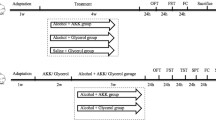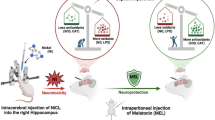Abstract
Extracts from the husk fiber of Cocos nucifera are used in folk medicine, but their actions on the central nervous system have not been studied. Here, the anxiolytic and antidepressant effects of the standardized hydroalcoholic extract of C. nucifera husk fiber (HECN) were evaluated. Male Swiss mice were treated with HECN (50, 100, or 200 mg/kg) 60 min before experiments involving the plus maze test, hole-board test, tail suspension test, and forced swimming test (FST). HECN was administered orally (p.o.) in acute and repeated-dose treatments. The forced swimming test was performed with dopaminergic and noradrenergic antagonists, as well as a serotonin release inhibitor. Administration of HECN in the FST after intraperitoneal (i.p.) pretreatment of mice with sulpiride (50 mg/kg), prazosin (1 mg/kg), or p-chlorophenylalanine (PCPA, 100 mg/kg) caused the actions of these three agents to be reversed. However, this effect was not observed after pretreating the animals with SCH23390 (15 µg/kg, i.p.) or yohimbine (1 mg/kg, i.p.) The dose chosen for HECN was 100 mg/kg, p.o., which increased the number of entries as well as the permanence in the open arms of the maze after acute and repeated doses. In both the forced swimming and the tail suspension tests, the same dose decreased the time spent immobile but did not disturb locomotor activity in an open-field test. The anxiolytic effect of HECN appears to be related to the GABAergic system, while its antidepressant effect depends upon its interaction with the serotoninergic, noradrenergic (α1 receptors), and dopaminergic (D2 dopamine receptors) systems.








Similar content being viewed by others

Abbreviations
- BUP:
-
Bupropion
- CNS:
-
Central nervous system
- DZP:
-
Diazepam
- EPM:
-
Elevated plus maze test
- FLUM:
-
Flumazenil
- FLX:
-
Fluoxetine
- FST:
-
Forced swimming test
- HECN:
-
Hydroalcoholic extract of C. nucifera husk fiber
- HPLC:
-
High-performance liquid cromathography
- IMP:
-
Imipramine
- NA:
-
Noradrenaline
- NEOA:
-
Number of entries in open arms
- OFT:
-
Open-field test
- PCPA:
-
p-Chlorophenylalanine
- PRA:
-
Prazosin
- SLA:
-
Spontaneous locomotor activity test
- SUL:
-
Sulpiride
- TPC:
-
Determination of total phenolic content
- TPOA:
-
Time of permanence in open arms
- TST:
-
Tail suspension test
- YOH:
-
Yohimbine
References
DebMandal M, Mandal S (2011) Coconut (Cocos nucifera L.: Arecaceae): in health promotion and disease prevention. Asian Pac J Trop Med 4(3):241–247
Aragão W (2002) Coco: pós-colheita. Série frutas do Brasil. Embrapa Informação tecnológica, Brasília
Senhoras E (2004) Agroindustrial green coconut chain opportunities: from green coconut nothing is lost, everything is used. Urutágua 5:1–10 (in Portuguese)
Carrijo O (2002) Fiber from the bark of green coconut as an agricultural substrate. Hortic Bras 20(4):533–535 (in Portuguese)
Esquenazi D, Wigg M, Miranda M, Rodrigues H, Tostes J, Rozental S, da Silva A, Alviano C (2002) Antimicrobial and antiviral activities of polyphenolics from Cocos nucifera Linn. (Palmae) husk fiber extract. Res Microbiol 153(10):647–652
Calzada F, Yépez-Mulia L, Tapia-Contreras A (2007) Effect of Mexican medicinal plant used to treat trichomoniasis on Trichomonas vaginalis trophozoites. J Ethnopharmacol 113(2):248–251
Costa C, Bevilaqua C, Morais S, Camurça-Vasconcelos A, Maciel M, Braga R, Oliveira L (2010) Anthelmintic activity of Cocos nucifera L. on intestinal nematodes of mice. Res Vet Sci 88(1):101–103
Huang Y, Nassar B, Horrobin D (1989) The prostaglandin outflow from perfused mesenteric vasculature of rats fed different fats. Prostaglandins Leukot Essent Fatty Acids 35(2):73–79
Koschek P, Alviano D, Alviano C, Gattass C (2007) The husk fiber of Cocos nucifera L. (Palmae) is a source of anti-neoplastic activity. Braz J Med Biol Res 40(10):1339–1343
Rinaldi S, Silva D, Bello F, Alviano C, Alviano D, Matheus M, Fernandes P (2009) Characterization of the antinociceptive and anti-inflammatory activities from Cocos nucifera L. (Palmae). J Ethnopharmacol 122(3):541–546
Lima E, Sousa C, Meneses L, Ximenes N, Santos Júnior M, Vasconcelos G, Lima N, Patrocínio M, Macedo D, Vasconcelos S (2015) Cocos nucifera (L.) (Arecaceae): a phytochemical and pharmacological review. Braz J Med Biol Res 48(11):953–964
Mendonça-Filho Rodrigues I, Alviano D, Santos A, Soares R, Alviano C, Lopes A, Rosa Mdo S (2004) Leishmanicidal activity of polyphenolic-rich extract from husk fiber of Cocos nucifera. Linn (Palmae). Res Microbiol 155(3):136–143
Silva R, Oliveira e Silva D, Fontes H, Alviano C, Fernandes P, Alviano D (2013) Anti-inflammatory, antioxidant, and antimicrobial activities of Cocos nucifera var typica. BMC Complement Altern Med 13:107
Assini F (2013) Pharmacological effects of aqueous extract of Solidago chilensis Meyen in mice. Rev Bras Plant Med 15(1):130–134 (in Portuguese)
Brochet D, Chermat R, DeFeudis F, Drieu K (1999) Effects of single intraperitoneal injections of an extract of Ginkgo biloba (EGb 761) and its terpene trilactone constituents on barbital-induced narcosis in the mouse. Gen Pharmacol 33(3):249–256
Citó M, Silva M, Santos L, Fernandes M, Melo F, Aguiar J, Lopes I, Sousa P, Vasconcelos S, Macêdo D, Sousa F (2015) Antidepressant-like effect of Hoodia gordonii in a forced swimming test in mice: evidence for involvement of the monoaminergic system. Braz J Med Biol Res 48(1):57–64
Shah P, Trivedi N, Bhatt J, Hemavathi K (2006) Effect of Withania somnifera on forced swimming test induced immobility in mice and its interaction with various drugs. Indian J Physiol Pharmacol 50(4):409–415
Lima E, de Sousa C, Vasconcelos G, Meneses L, E Silva Pereira Y, Ximenes N, Santos Júnior M, Matos N, Brito R, Miron D, Leal L, Macêdo D, Vasconcelos S (2016) Antidepressant, antioxidant and neurotrophic properties of the standardized extract of Cocos nucifera husk fiber in mice. J Nat Med 70(3):510–521
Kaster M, Santos A, Rodrigues A (2005) Involvement of 5-HT1A receptors in the antidepressant-like effect of adenosine in the mouse forced swimming test. Brain Res Bull 67(1–2):53–61
Machado D, Kaster M, Binfaré R, Dias M, Santos A, Pizzolatti M, Brighente I, Rodrigues A (2007) Antidepressant-like effect of the extract from leaves of Schinus molle L. in mice: evidence for the involvement of the monoaminergic system. Prog Neuropsychopharmacol Biol Psychiatry 31(2):421–428
Archer J (1973) Tests for emotionality in rats and mice: a review. Anim Behav 21(2):205–235
Lister RG (1987) The use of a plus-maze to measure anxiety in the mouse. Psychopharmacol 92(2):180–185
Clark G, Koster A, Person D (1971) Exploratory behavior in chronic disulfoton poisoning in mice. Psychopharmacology 20:169–171
Steru L, Chermat R, Thierry B, Simon P (1985) The tail suspension test: a new method for screening antidepressants in mice. Psychopharmacology 85(3):367–370
Porsolt R, Bertin A, Jalfre M (1977) Behavioral despair in mice: a primary screening test for antidepressants. Arch Int Pharmacodyn Ther 229(2):327–336
Russell J, Douglas A, Brunton P (2008) Reduced hypothalamo-pituitary-adrenal axis stress responses in late pregnancy: central opioid inhibition and noradrenergic mechanisms. Ann N Y Acad Sci 1148:428–438
Starr B, Starr M (1986) Differential effects of dopamine D1 and D2 agonists and antagonists on velocity of movement, rearing and grooming in the mouse. Implications for the roles of D1 and D2 receptors. Neuropharmacology 25(5):455–463
Takeda H, Tsuji M, Matsumiya T (1998) Changes in head-dipping behavior in the hole-board test reflect the anxiogenic and/or anxiolytic state in mice. Eur J Pharmacol 350(1):21–29
Blanchard D, Griebel G, Blanchard R (2001) Mouse defensive behaviors: pharmacological and behavioral assays for anxiety and panic. Neurosci Biobehav Rev 25(3):205–218
Hanrahan J, Chebib M, Johnston G (2011) Flavonoid modulation of GABA(A) receptors. Br J Pharmacol 163(2):234–245
Jäger A, Saaby L (2011) Flavonoids and the CNS. Molecules 16(2):1471–1485
Nilsson J, Sterner O (2011) Modulation of GABA(A) receptors by natural products and the development of novel synthetic ligands for the benzodiazepine binding site. Curr Drug Targets 12(11):1674–1688
Wolfman C, Viola H, Paladini A, Dajas F, Medina J (1994) Possible anxiolytic effects of chrysin, a central benzodiazepine receptor ligand isolated from Passiflora coerulea. Pharmacol Biochem Behav 47(1):1–4
Campbell E, Chebib M, Johnston G (2004) The dietary flavonoids apigenin and (−)-epigallocatechin gallate enhance the positive modulation by diazepam of the activation by GABA of recombinant GABA(A) receptors. Biochem Pharmacol 68(8):1631–1638
Willner P (1990) Animal models of depression: an overview. Pharmacol Ther 45(3):425–455
Ramireza K, Sheridana JF (2016) Antidepressant imipramine diminishes stress-induced inflammation in the periphery and central nervous system and related anxiety- and depressive- like behaviors. Brain Behav Immun 57:293–303
Ren L, Wang F, Xu Z, Chan W, Zhao C, Xue H (2010) GABA(A) receptor subtype selectivity underlying anxiolytic effect of 6-hydroxyflavone. Biochem Pharmacol 79(9):1337–1344
Waldmeier P (1987) Amine oxidases and their endogenous substrates (with special reference to monoamine oxidase and the brain). J Neural Transm Suppl 23:55–72
De Boer A, Gaillard P (2007) Drug targeting to the brain. Annu Rev Pharmacol Toxicol 47:323–355
Németh K, Plumb G, Berrin J, Juge N, Jacob R, Naim H, Williamson G, Swallow D, Kroon P (2003) Deglycosylation by small intestinal epithelial cell beta-glucosidases is a critical step in the absorption and metabolism of dietary flavonoid glycosides in humans. Eur J Nutr 42(1):29–42
Youdim K, Dobbie M, Kuhnle G, Proteggente A, Abbott N, Rice-Evans C (2003) Interaction between flavonoids and the blood–brain barrier: in vitro studies. J Neurochem 85(1):180–192
Maletic V, Robinson M, Oakes T, Iyengar S, Ball S, Russell J (2007) Neurobiology of depression: an integrated view of key findings. Int J Clin Pract 61(12):2030–2040
Dailly E, Chenu F, Renard C, Bourin M (2004) Dopamine, depression and antidepressants. Fundam Clin Pharmacol 18(6):601–607
Martin-Soelch C (2009) Is depression associated with dysfunction of the central reward system? Biochem Soc Trans 37(1):313–317
Meyer J, McNeely H, Sagrati S, Boovariwala A, Martin K, Verhoeff N, Wilson A, Houle S (2006) Elevated putamen D(2) receptor binding potential in major depression with motor retardation: an [11C]raclopride positron emission tomography study. Am J Psychiatry 163(9):1594–1602
Vaugeois J, Pouhé D, Zuccaro F, Costentin J (1996) Indirect dopamine agonists effects on despair test: dissociation from hyperactivity. Pharmacol Biochem Behav 54(1):235–239
O’Leary O, Bechtholt A, Crowley J, Hill T, Page M, Lucki I (2007) Depletion of serotonin and catecholamines block the acute behavioral response to different classes of antidepressant drugs in the mouse tail suspension test. Psychopharmacology 192(3):357–371
Redrobe J, Bourin M, Colombel M, Baker G (1998) Dose-dependent noradrenergic and serotonergic properties of venlafaxine in animal models indicative of antidepressant activity. Psychopharmacology 138(1):1–8
Szewczyk B, Poleszak E, Wlaź P, Wróbel A, Blicharska E, Cichy A, Dybała M, Siwek A, Pomierny-Chamioło L, Piotrowska A, Brański P, Pilc A, Nowak G (2009) The involvement of serotonergic system in the antidepressant effect of zinc in the forced swim test. Prog Neuropsychopharmacol Biol Psychiatry 33(2):323–329
Acknowledgments
The authors would like to thank the National Council for Technological and Scientific Development (CNPq), the Coordination for the Improvement of Higher Education Personnel (CAPES), and the Ceará Foundation for the Support of Scientific and Technological Development (FUNCAP).
Author information
Authors and Affiliations
Corresponding author
Rights and permissions
About this article
Cite this article
Lima, E.B.C., de Sousa, C.N.S., Meneses, L.N. et al. Involvement of monoaminergic systems in anxiolytic and antidepressive activities of the standardized extract of Cocos nucifera L.. J Nat Med 71, 227–237 (2017). https://doi.org/10.1007/s11418-016-1053-6
Received:
Accepted:
Published:
Issue Date:
DOI: https://doi.org/10.1007/s11418-016-1053-6



